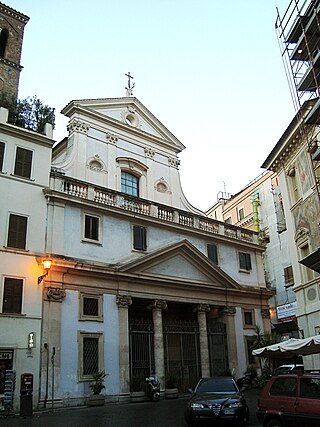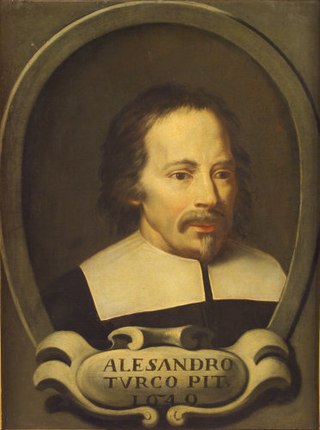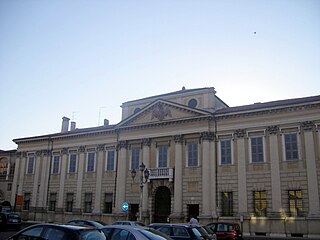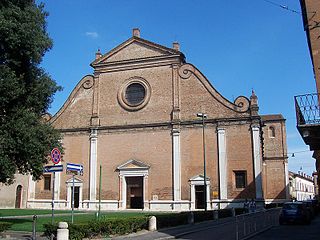Santo Stefano is a Paleo-Christian, Roman Catholic basilica church in central Verona, region of Veneto, Italy.

Santo Stefano is a Paleo-Christian, Roman Catholic basilica church in central Verona, region of Veneto, Italy.

A church at this site, built on an Isis dedicated Roman temple, was consecrated in 421, and for four centuries was the burial site for the bishops of Verona. [1] For a time, this served as cathedral of the city. The church was partially damaged during the earthquake of 1117. It was subsequently reconstructed in Romanesque style.
The façade is made up of rows of soft stone and brick. During the 10th-century, the crypt was built. The four central dark granite columns are of Egyptian origin. The octagonal lantern with a double row of mullioned windows is an example of Lombard Romanesque. The belltower contains six bells in F#, hung for Veronese bellringing art [2]
The two-storey apse has elements from the early Christian era and from the early Middle Ages.
An inventory of 1750 noted the main altarpiece and the choir were decorated by Domenico Brusasorzi. [3] Martino da Verona's Annunciation and Coronation of the Virgin is located in the left transept. The Tribune was frescoed by Bernardo Muttoni. Some figure above the main altar were painted by Santo Prunati; however the ceiling and the cupola frescoes were mainly by Brusasorzi. He also painted an Adoration of the Magi for the first altar to right. The next altar on the right had a work by Giulio Carpioni the younger, a relative of Giulio Carpioni.

The "Chapel of the Innocents" was commissioned around 1618 by the parish priest, Monsignor Varalli. It was built in Baroque style along the southern wall to the right of the entrance. It has an altarpiece depicting the Massacre of Innocents by Pasquale Ottino and a Martyrdom of 40 martyrs by Alessandro Turchi (L'Orbetto). There are also frescoes by Marcantonio Bassetti, and an Annuciation and frescoes of San Carlo and St Francis by Ottino.
The first altar on the left had a canvas depicting the Virgin and Child with Saints Peter and Andrew by Giovanni Francesco Caroto. To the sides of this altarpiece were paintings of Melchisidech and the Sacrifice of Isaac by Francesco Barbieri. The second altar had a Virgin and Child with Saints Jerome, Francis, Mauro, Simplicio, and Placido by Niccolo Giolfino. A frescoed lunette was completed by Giovanni Battista dal Moro.
In the last altar on left is a Virgin and Child with Saints Joseph, John the Baptist, Francis, and Anthony of Padua by Alessandro Marchesini, and a Virgin and Child with Saints Vicenzo, Stefano, Anthony Abbot, and Francesco di Paola by Santo Prunati. Next to that altar was a Holy Spirit descends among the Apostles by Orazio Farinati. [4]
The crypt has frescoes by Giulio Carpioni younger (Visitation and Repose in Egypt); Paolo Cimengoli (Annunciation); [5] and Santo Prunati (Nativity), it held a copy of Raphael. [6]

Vincenzo Foppa was an Italian painter from the Renaissance period. While few of his works survive, he was an esteemed and influential painter during his time and is considered the preeminent leader of the Early Lombard School. He spent his career working for the Sforza family, Dukes of Milan, in Pavia, as well as various other patrons throughout Lombardy and Liguria. He lived and worked in his native Brescia during his later years.

San Francesco a Ripa is a church in Rome, Italy. It is dedicated to Francis of Assisi who once stayed at the adjacent convent. The term Ripa refers to the nearby riverbank of the Tiber.

Sant'Anna dei Lombardi,, and also known as Santa Maria di Monte Oliveto, is an ancient church and convent located in piazza Monteoliveto in central Naples, Italy. Across Monteoliveto street from the Fountain in the square is the Renaissance palace of Orsini di Gravina.

Cremona Cathedral, dedicated to the Assumption of the Blessed Virgin Mary, is a Catholic cathedral in Cremona, Lombardy, northern Italy. It is the seat of the Bishop of Cremona. Its bell tower is the famous Torrazzo, symbol of the city and tallest pre-modern tower in Italy.

Mantua Cathedral in Mantua, Lombardy, northern Italy, is a Roman Catholic cathedral dedicated to Saint Peter. It is the seat of the Bishop of Mantua.

Sant'Eustachio is a Roman Catholic titular church and minor basilica in Rome, named for the martyr Saint Eustace. It is located on Via di Sant'Eustachio in the rione Sant'Eustachio, a block west of the Pantheon and via della Rotonda, and a block east of Sant'Ivo alla Sapienza and the Via della Dogana Vecchia.

The Basilica della Santissima Annunziata del Vastato is the Catholic cathedral of Genoa, northern Italy; its decoration employed the major baroque studios and artists in Genoa in the 17th century.

Alessandro Turchi was an Italian painter of the early Baroque, born and active mainly in Verona, and moving late in life to Rome. He also went by the name Alessandro Veronese or the nickname L'Orbetto. His style has been described as soft and Caravaggesque at the same time.

San Bernardino is a church in Verona, northern Italy. The church, in Gothic style, was built from 1451 to 1466.

The church of Sant'Eufemia is a Catholic place of worship located in the heart of Verona's historic center. It straddles an ancient Roman cardo, where a church building probably already existed in the 6th century. The foundation of the present church is owed to the Della Scala family, who brought Augustinian hermit monks to Verona in 1262 so that they could be closer to the community and granted them permission to build a monastery, located at the time in the Capitani quarter of the Scaliger city. Through bequests and donations, particularly that of Alberto della Scala, the building could be consecrated in 1331 by the bishop of Verona Nicolò. The building activity, however, did not end, and in the following years the monastery's rooms continued to be expanded in order to accommodate the increasing number of monks who arrived there attracted by the great prestige the community boasted. A permit granted by Mastino II della Scala in 1340 made it possible to further enlarge the church by building the vast apse that still distinguishes it today. From the end of the fourteenth century work continued on the various chapels and minor altars.

The Basilica of San Fedele in Como is located in the city center. The present Romanesque church dates from 1120 and is dedicated to the Fidelis of Como.

San Procolo is a Paleo-Christian, Roman Catholic small temple standing adjacent to the Basilica di San Zeno in central Verona, region of Veneto, Italy.

San Lorenzo is a Romanesque style, Roman Catholic church on Corso Cavour in central Verona, region of Veneto, Italy.

Santa Maria in Chiavica is a former Roman Catholic church, now deconsecrated, in the Renaissance style, located on Via S. Maria in Chiavica number 7 in central Verona, region of Veneto, Italy. The building retains portions of its original Romanesque structure and original fresco and altar decoration, but is now used for theatrical and musical performances.

The Palazzo D'Arco is a Neoclassical-style palace located on Piazza Carlo D'Arco #4 in Mantua, region of Lombardy, Italy. The palace houses the Museo di Palazzo d'Arco, which displays the furnishings and artwork collected by the Duke D'Arco.

San Francesco is a late-Renaissance, Roman Catholic minor basilica church located on via Terranuova in Ferrara, Emilia-Romagna, Italy.

San Lorenzo is a Gothic architecture, Roman Catholic Basilica church in Mortara, Province of Pavia, region of Lombardy, Italy.

San Fortunato is a Gothic- and Renaissance-style, Roman Catholic church located on Piazza Umberto I #6 in the historic center of Todi, province of Perugia, region of Umbria, Italy.

Santa Maria in Vanzo is a Renaissance-style, Roman Catholic church in Padua, region of Veneto, Italy.

San Francesco is a Romanesque and Gothic-style, Roman Catholic church located at Piazza San Francesco in Pescia, region of Tuscany, Italy.